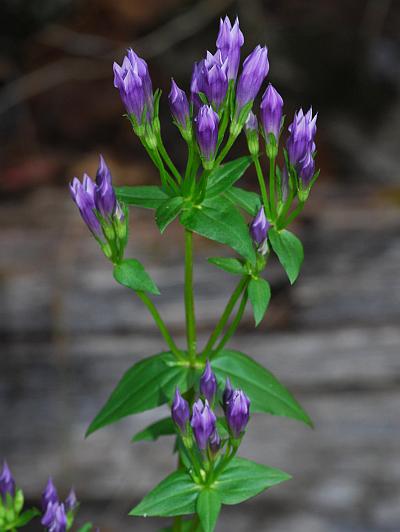Gentianella quinquefolia (L.) Small
Stiff Gentian

Native
CC = 10
CW = -3
MOC = 14
© SRTurner
Gentianella quinquefolia (L.) SmallStiff Gentian | |
 |
Native CC = 10 CW = -3 MOC = 14 |
© SRTurner |
|
Family - Gentianaceae Habit - Annual or biennial forb. Stems - To 60cm tall, erect, herbaceous, from a taproot, branching, glabrous, winged (the wings to 1mm broad), terete, hollow, somewhat purplish at the base (in the sun), single from the base. Lateral branches ascending.
Leaves - Opposite, sessile, decussate, glabrous, entire, ovate, mostly rounded at the apex, with evident parallel venation (especially abaxially), to 4cm long, +2cm broad. Leaves reduced to bracts in inflorescence.
Inflorescence - Terminal and axillary umbellate cymes. Cymes bracteate. Pedicels erect, to +1cm long, glabrous, minutely winged (use a lens to see). Pair of foliaceous bracts subtending each division of cyme. Flowers - Corolla tubular, 5-lobed, bluish-purple, glabrous internally and externally, to 2.3cm long. Lobes triangular, acute, 5-8mm long, typically closing the apex of the flower. Stamens 5, alternating with the corolla lobes, adnate about 1/3 up from the base of the corolla tube, included. Filaments white, glabrous, to 1cm long. Anthers to 2-3mm long, purplish-white. Ovary superior, stalked (the stalk to 5mm long in flower), glabrous, green, +1cm long, unilocular, many-seeded (ovuled). Placentation parietal. Stigmas 2, flattened, curled, purple. Style basically absent. Calyx tube campanulate, to 3mm long, glabrous, 5-lobed, glabrous internally and externally. Lobes linear-subulate, erect, with a prominent midrib, acute, entire, to -5mm long, +1mm broad, glabrous.
Flowering - August - November. Habitat - Moist ground along rocky wooded banks, ledges, and thickets, also along streams and in moist woodland. Origin - Native to the U.S. Lookalikes - None when flowering. Vegetatively resembles Sabatia angularis and others. Other info. - This beautifully striking species is found mainly in the eastern Ozark section of Missouri but is also found in a few northeastern counties. The plant is easy to ID in flower but can be mistaken for other species in the family when observed vegetatively. Traditionally the roots of the plant were used to make a tincture or tea that would remedy weak appetite and stimulate digestion. These mixtures were also used for headaches, hepatitis, jaundice, and consumption. Photographs taken at St. Francois State Park, St. Francois County, MO, 10-24-2011, and at Johnson's Shut-Ins State Park, Reynolds County, MO, 10-1-2018 (SRTurner). |